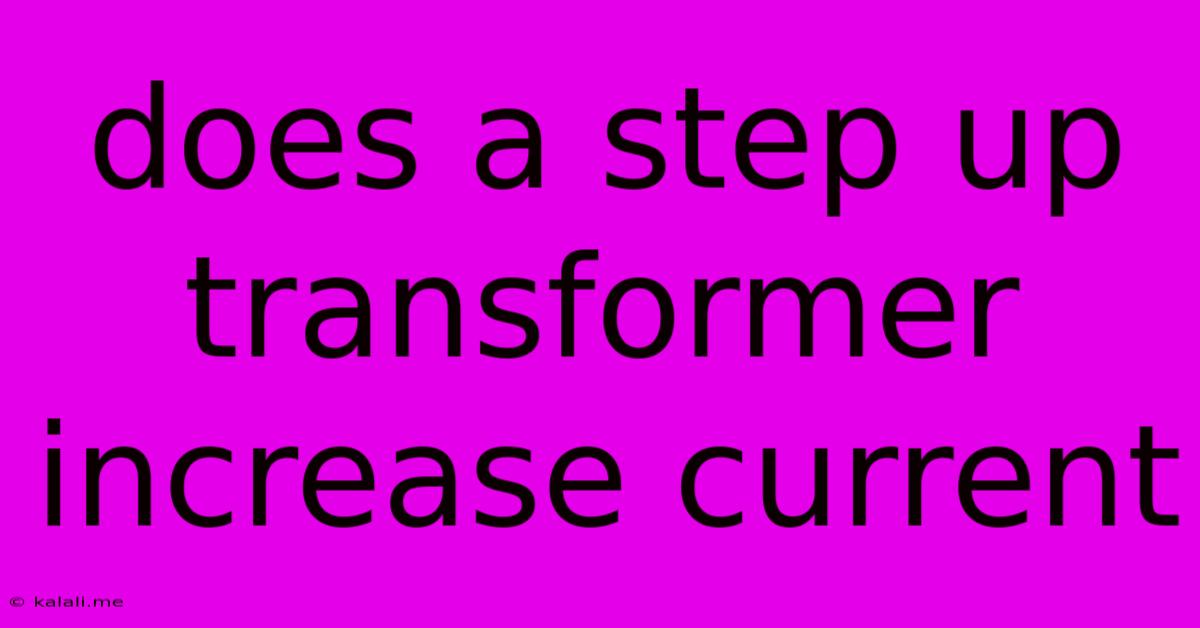Does A Step Up Transformer Increase Current
Kalali
May 09, 2025 · 3 min read

Table of Contents
Does a Step-Up Transformer Increase Current? Understanding Power, Voltage, and Current Relationships
A common misconception surrounding step-up transformers is that they magically increase both voltage and current. This isn't the case. While a step-up transformer efficiently boosts the voltage, it actually decreases the current, maintaining a relatively constant power output. This article will delve into the intricacies of transformer operation to clarify this fundamental concept.
Understanding the Basics of Transformers
Transformers are passive electrical devices that transfer electrical energy between two or more circuits through electromagnetic induction. They consist of two coils of wire, the primary and secondary coils, wound around a common magnetic core. The core facilitates the efficient transfer of magnetic flux between the coils.
A step-up transformer increases the voltage from the primary coil to the secondary coil. This is achieved by having more turns of wire in the secondary coil than in the primary coil. The ratio of the number of turns determines the voltage transformation ratio.
The Conservation of Power
The key to understanding the relationship between voltage and current in a transformer lies in the principle of conservation of power. Ideally, a transformer is highly efficient, meaning that the power input to the primary coil is approximately equal to the power output from the secondary coil. Power (P) is the product of voltage (V) and current (I):
- P = V x I
Therefore, if the voltage (V) is increased in a step-up transformer, the current (I) must decrease proportionally to maintain a constant power output. This is why a step-up transformer doesn't increase current; it prioritizes increasing voltage at the expense of current.
Real-World Considerations and Losses
While the ideal scenario describes a perfect power transfer, real-world transformers experience energy losses due to several factors:
- Copper Losses (I²R losses): These losses are due to the resistance of the copper wire in the coils, generating heat. Higher currents lead to greater copper losses.
- Core Losses (Hysteresis and Eddy Current Losses): These losses occur within the magnetic core due to the alternating magnetic field.
- Leakage Flux: Not all magnetic flux generated by the primary coil reaches the secondary coil; some "leaks" out.
These losses slightly reduce the efficiency of the transformer, meaning the output power will be slightly less than the input power. However, the fundamental principle remains: a step-up transformer trades increased voltage for decreased current to maintain near-constant power.
Practical Applications and Examples
Step-up transformers are vital components in various applications, including:
- Power Transmission: High-voltage transmission lines utilize step-up transformers to increase voltage and reduce current, minimizing energy loss during long-distance power transmission. The voltage is then stepped down at substations closer to consumers for safe usage.
- Electronic Devices: Many electronic devices use step-up transformers to generate higher voltages needed for specific components.
In Conclusion:
A step-up transformer does not increase current; instead, it increases voltage while proportionally decreasing current to maintain near-constant power. This fundamental principle is governed by the conservation of energy and is crucial to understanding the operation and applications of transformers in various electrical systems. While losses exist in real-world scenarios, the core principle of voltage increase coupled with current decrease remains consistent.
Latest Posts
Latest Posts
-
How Much Ml Is A Gallon
May 09, 2025
-
67 Out Of 80 As A Percentage
May 09, 2025
-
31 8 As A Mixed Number
May 09, 2025
-
Convert 425 Degrees Fahrenheit To Celsius
May 09, 2025
-
How To Calculate 25 Percent Of A Number
May 09, 2025
Related Post
Thank you for visiting our website which covers about Does A Step Up Transformer Increase Current . We hope the information provided has been useful to you. Feel free to contact us if you have any questions or need further assistance. See you next time and don't miss to bookmark.